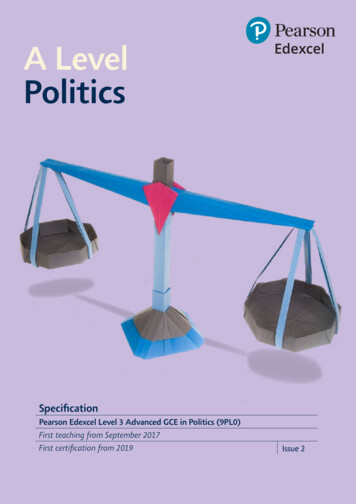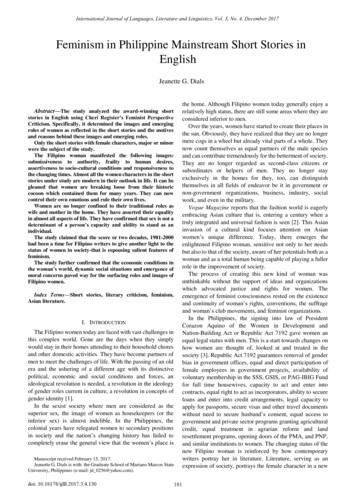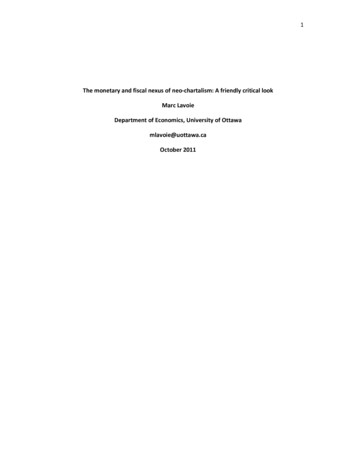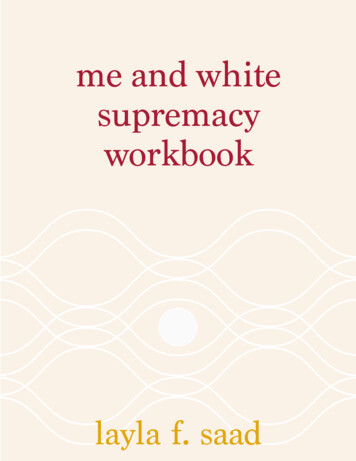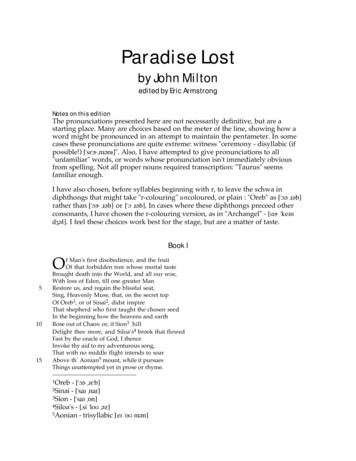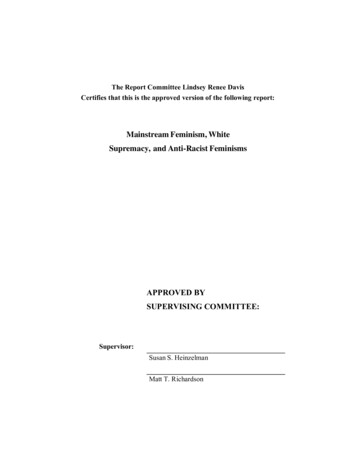
Transcription
The Report Committee Lindsey Renee DavisCertifies that this is the approved version of the following report:Mainstream Feminism, WhiteSupremacy, and Anti-Racist FeminismsAPPROVED BYSUPERVISING COMMITTEE:Supervisor:Susan S. HeinzelmanMatt T. Richardson
Mainstream Feminism, WhiteSupremacy, and Anti-Racist FeminismsbyLindsey Renee DavisReportPresented to the Faculty of the Graduate School ofThe University of Texas at Austinin Partial Fulfillmentof the Requirementsfor the Degree ofMaster of ArtsThe University of Texas at AustinDecember 2017
AbstractMainstream Feminism, White Supremacy,and Anti-Racist FeminismsLindsey Renee Davis, MAThe University of Texas at Austin, 2017Supervisor: Susan S. HeinzelmanAbstract: The history of the women’s movement is one of great gains, as well asmissed opportunities, due to the domination of the movement by those women with themost privilege. This report discusses the challenge faced by the mainstream women’smovement to overcome racism and prejudice while trying to remain relevant to manydifferent women. I discuss white supremacy within the mainstream women’s movementas well as scholarship on anti-racist feminism, with a focus on women of Colorfeminisms and critical whiteness studies. Following Kimberlé Crenshaw and ChandraMohanty, I argue that the issues of the most marginalized women should be central to thewomen’s movement’s projects of feminist liberation. While the constraints to women’sliberation will continue to pose challenges through the commodification anddomestication of radical politics by liberalism and the neoliberal academy, feminismcontinues to hold possibilities for women fighting to overcome oppression.iii
Table of ContentsPREFACE .1Chapter 1: Feminism and White Supremacy .6HISTORY OF WHITE SUPREMACY WITHIN MAINSTREAM FEMINISM . 11Chapter 2: Woman of Color Feminisms .16POLITICS AND ACADEMIC FEMINISMS . 25Chapter 3: Challenges and Opportunities for the Women’s Movement .30INTERCONNECTIONS . 37CONCLUSION . 40Bibliography .44iv
PREFACEThe reason racism is a feminist issue is easily explained by theinherent definition of feminism. Feminism is the political theoryand practice to free all women: women of color, working-classwomen, poor women, physically challenged women, lesbians, oldwomen, as well as white economically privileged heterosexualwomen. Anything less than this is not feminism, but merely femaleself-aggrandizement.-- Barbara SmithThe history of the mainstream women’s movement is replete with examples of its failureto incorporate an analysis of race- and class-based oppression into a praxis of women’sliberation. White feminism, also known as single-issue feminism, is notorious for failing toaccount for the experiences of women of Color while claiming to advocate for the equality of allwomen.1 Instead, an essentialized version of “woman,” reflecting the standpoint of privileged,middle-class white women, tends to dominate mainstream feminist discourse. Despite someprogress towards a shared understanding of the multiplicity of oppressions within the mainstream1Following Aída Hurtado, I will write people of Color or women of Color to refer to persons orwomen racialized as non-white in the U.S. “Black” and “Color” will be capitalized because theyrefer to a variety of specific ethnicities. “On the other hand, white is left in lowercase lettersbecause it refers not to one ethnic group or to specified ethnic groups but to many.” I will notchange the capitalization used by other authors. See footnotes 1 and 4 in “Relating to Privilege:Seduction and Rejection in the Subordination of White Women and Women of Color." Signs,vol. 14, no. 4, 1989, pp. 833-834, doi:10.1086/494546.1
women’s movement, as well as the presence of women of Color speaking on their own behalf,the articulation of explicitly anti-racist policies remains a challenge. This report will focusexclusively on anti-racism as it intersects with feminism. I will show how women of Color haveadvocated for themselves throughout the history of the women’s movement and highlight thecritiques and suggestions they have provided, particularly in relation to the context of theacademy and the neoliberal political environment. Lastly, the report will discuss contemporarychallenges and opportunities for anti-racist feminisms to facilitate alliances. I will argue that thestruggles of the most marginalized women need to be central to the project of feminism if thewomen’s movement is to effect the liberation of all women.The 2017 Women’s March on Washington and its associated sister marches (henceforthreferred to as WMW) serve as a microcosmic illustration of the need to center marginalizedwomen within the mainstream. During the 12 weeks between the march’s conception,immediately following the election of Donald Trump to the U.S. Presidency until the day of themarch itself on January 21st, the planning and execution of the event illustrated manyproblematic dynamics that have been repeated throughout the history of the mainstreamwomen’s movement (Lemieux; Mosthof). Women of Color were brought onto the leadershipteam only when it was obvious that an all-white planning team projected white supremacistracial exclusion (Lemieux; Stockman). After calls to change the name from Million Women’sMarch to something that was not appropriated from Black women’s political labor, the name waschanged to the Women’s March on Washington, which was also appropriative of the CivilRights era March on Washington for Jobs and Freedom (Booker; Dejean; Walters). Towards theend of the planning period, the published unity principles (also known as the policy platform)was lauded as radically feminist (Vagianos; Kelly). The march itself did not always mirror the2
expansiveness of those principles, as I will explain below. Attempts to make the WMW a spaceexplicitly welcome to women of Color alienated some white women. Those women withdrewtheir involvement, suggesting they felt that a space where white women were encouraged tocheck their privilege and to read the writing of women of Color was therefore not welcome towhite women (Stockman).Coincidental with women’s empowerment at the WMW marches, attendees also sawcultural appropriation as white women carried signs using African-American Vernacular Englishor otherwise featuring cultural aspects associated with Blackness (Wortham). There were, forexample, white women holding posters with phrases such as "ladies, let’s get in formation,”which references a song by Beyoncé, “equal pay for equal twerk,” and “it’s lit,” alongside adrawing of a burning bra (Mejia; Prokop; Laub). Appropriating the creative and intellectual laborof women of Color, white feminists structurally support white supremacy.2 Such appropriation isalso a factor of neoliberal anti-Blackness whereby pop culture swallows up the bodies of womenof Color. Further, despite the inclusion of transwomen within the policy platform and asspeakers, many of the WMW attendees around the country insisted on gender essentialism(Mosthof). From pink pussy hats and signs depicting vulva as beautiful flowers, the message wasclear that womanhood is still equated with possessing a very specific set of genitalia.It is important to begin examining white supremacy within the women’s movement byproviding some definitions for concepts that are often misunderstood or given contradictingdefinitions. Early definitions of racism focused solely on interpersonal prejudice, but now weunderstand racism as inextricably interconnected to social systems of power. Sociologist Edward2While many associate white supremacy with neo-nazis or the KKK, I will refer to whitesupremacy as related to a system wherein whiteness is valued above non-whiteness,institutionally, culturally, and interpersonally. I will refer to white supremacists as people whoespouse overtly racist beliefs.3
Bonilla Silva explains that there are multiple schools of thought on the subject of definingracism– the institutionalist, internal colonialist, and the racial formation perspectives, but thatthey all have limitations. Instead, he argues for an alternative framework of racialialized socialsystems to provide an understanding of racial phenomena (467, 469). Beverley Daniels Tatum, apsychologist, administrator, and educator known as a race specialist, explains that antiracisttrainers often share a common definition of racism as prejudice plus power. However, sheexplains that this definition has little resonance with her white students and so she prefers DavidWellman’s definition that explains racism as a ‘system of advantage based on race’ (127). Antiracism is a praxis combining theory with action seeking to undo racialized prejudice,discrimination, and oppression, at the individual, institutional, and cultural levels. Anti-racismaddresses the social constitutedness of race and sees racism as an institutional and systemicdynamic that also influences interpersonal relationships and life circumstances. Race, likegender, is part of a socially constructed hierarchy that is unfixed, historical, and fluid (Omi andWinant; West and Zimmerman). Whiteness is defined by feminist and sociologist RuthFrankenberg as “a location of structural advantage, of race privilege. Second, it is a “standpoint”,a place from which white people look at ourselves, at others and at society. Third “whiteness”refers to a set of cultural practices that are usually unmarked and unnamed” (1).Philosopher Linda Martín Alcoff argues that race discourse should encompass multipleracisms because the treatment of different groups is often related to their specific, localizedcontext (122). Andrea Smith, co-founder of anti-violence organization INCITE!, explains thatthere are three main pillars of white supremacy within the U.S. She explains that anti-Blackness“anchors” capitalism, the genocide of Indigenous peoples supports settler colonialism, andorientalism upholds war (56-57). Racial projects of minoritization serve to uphold the United4
States’ systemic white supremacy. Within this report, I focus heavily on Black women’sresponses to racism and sexism but this is not intended to promote a false Black and white binaryperspective of race and racism. Alcoff explains that it can be difficult to critique this popularmisunderstanding of U.S. race relations because of our context of overwhelming anti-Blackness.However, not only does the binary fail to incorporate racialized communities that fall outside ofthe Black or white dichotomy, it is also necessary to understand the many different ways thatracism is manifested in order to address anti-Blackness (121).5
Chapter 1: Feminism and White SupremacyWhite supremacy, which bestows racial privilege on those who are identified as “white,”is a pervasive system of oppression that manifests itself within the women’s movement in overtand covert ways. This section will discuss the relationship between privilege and whitesupremacy as well as how white supremacy manifests itself within feminism.White feminism can be defined as single-issue feminism, where gender oppression isunderstood as the most harmful type of oppression experienced by women. Some single-issuefeminists go so far as to claim that patriarchy is the primary system of oppression from which allother forms of oppression are derived. White feminism’s single-lens analysis, which onlyconsiders gender disjointedly from other aspects of women’s identity, cannot account for thelives of those who are impacted by multiple systems of oppression, such as racism, ableism, andclassism, within a matrix of multiple, interacting forms of domination (Collins). There are manybranches of feminism that allow for a number of feminist lenses with which to view the world –Chicana feminism, Womanism, Black feminism, socialist feminism, and ecofeminism to name afew. However, despite these many options, mainstream feminism continues to be dominated bysingle-issue (white) feminism, which has as its primary goal equality with men, in terms of equalaccess to jobs and equal pay for those labors. The ‘lean-in’ brand of white feminism exemplifiesthis equality idea (Hess). However, as bell hooks in Feminist Theory: From Margin to Center(1984) argues, this goal begs the question to which men women want to be equal:Since men are not equals in white supremacist, capitalist,patriarchal class structure, which men do women want to be equalto? Do women share a common vision of what equality means?Implicit in this simplistic definition of women’s liberation is a6
dismissal of race and class as factors that, in conjunction withsexism, determine the extent to which an individual will bediscriminated against, exploited, or oppressed. (18)Often within mainstream feminism, race and class are dismissed as factors as white feminists tryto impose ideas about “sisterhood” and women’s liberation. For women with socioeconomicprivilege, it appears that as long as (some) women have opportunities to participate on equalfooting with men in the white, supremacist, patriarchal, capitalist economy, there is little more tobe achieved. Those left outside of this narrow definition of feminism, however, have createdtheir own feminisms that respond to their lived experiences.The research and scholarship that forms the body of critical whiteness studies can behelpful to the mainstream feminist movement. Privilege discourse is one of the most commonand powerful ways that people today are taught to understand the power dynamics behindpatriarchy and racism. Peggy McIntosh, who is the founder of the National SEED Project(Seeking Educational Equity and Diversity) and former associate director of the WellesleyCenters for Women, is well known for her essays on white privilege and male privilege.Reflecting on the oppressiveness of privilege, McIntosh wrote: “After I realized the extent towhich men work from a base of unacknowledged privilege, I understood that much of theiroppressiveness was unconscious. Then I remembered the frequent charges from women of Colorthat white women whom they encounter are oppressive.” The power dynamics and difficultyforming alliances between white women and women of Color are shaped by this privilege.Zeus Leonardo, who is a professor of education and critical social theorist at UCBerkeley, explains that it is necessary to move beyond conversations about white privilege toprovide equal attention to white supremacy. He argues that while white supremacy is the7
structure that permits white privilege, the realization of one’s racial privilege (as a white person)does little to challenge this structure. Furthermore, unidirectional conceptions of white privilegethat focus on invisible benefits downplay the violence of white domination, where underlying thewhole system is the “active role of whites who take resources from people of Color all over theworld, appropriate their labor, and construct policies that deny minorities’ full participation insociety” (138). The price of white privilege, in other words, is paid for by the oppression ofpeople of Color. White people are often protected from knowledge of the ways in which they arebenefited by oppression through the distance of globalization as well as the everyday segregationbetween differently colored communities in the U.S. Thus not only are many white peopleunaware of their racial privilege, many would also wholly deny the pervasiveness and urgency ofwhite supremacy.Thus the notion of privilege has become quite controversial for many people who believethe term is used as an insult; anti-racism is interpreted by conservatives as “anti-white.”3 Somego so far as to say that white people are the victims of reverse-racism. They see “privilege” as anaffront to hard-working Americans who accuse anti-racists of trying to make them feel “guilty”of being born white – their only crime. However, understanding that one benefits from aparticular form of privilege does not mean that your life is without difficulty nor is it an attackupon one’s character. The internalization of white supremacist values and internalized beliefs inracial superiority can lead some with privilege to deny the history and power dynamics thatbenefit them. Such reformulations of privilege and anti-racism serve as a defense mechanism forpeople to maintain their power and privilege rather than to strive for changes toward a more3See for example: Roberts, Paul C. "Political Correctness often Means Reverse Racism." HumanEvents, 1999, pp. 22.8
equitable society. Furthermore, researchers from Stanford University have found that whitepeople often exaggerate hardships in their lives in order to deflect accusations of racial privilege(Phillips and Lowery). White people who are provided evidence of racial privilege will concoctvarious reasons (hardships) for why the concept of privilege does not apply to them, whilesimultaneously acknowledging the role that privilege plays in maintaining hierarchy within thegreater society. Those white people who see themselves as benefiting less from white privilegebecause of hardships are often unsupportive of policies intended to increase racial equity, such asaffirmative action (Phillips and Lowery 12-13).Such defensiveness can be understood as a symptom of white fragility, a conceptpopularized by a 2011 article from Whiteness Studies scholar, Robin DiAngelo. She explainswhite fragility as “a state in which even a minimum amount of racial stress becomes intolerable,triggering a range of defensive moves” that white people use to avoid taking responsibility forracial privilege (54). When white people are confronted with information about structures ofracial domination from which they benefit, they may be overcome with negative affect thatproduces immobilization such as guilt, helplessness, anger, and sadness. These overwhelmingemotional responses may be unintended, “normal” and “natural,” but can have the effect ofdisrupting attempts at working towards racial justice. DiAngelo quotes social work educatorRich Vodde to explain the significance of behaviors of white fragility: “If privilege is defined asa legitimization of one’s entitlement to resources, it can also be defined as permission to escapeor avoid any challenges to this entitlement” (65). This can result in, for example, inequitablewealth accumulation that goes unquestioned when taxes are manipulated to maintain austeritymeasures that hurt people of Color and women and poor children the most.9
Alcoff (2006) describes conditions that encourage involvement in overt white supremacy:a lack of critical education around the social, political, and historical factors that are creatingcurrent conditions, coupled with a failing economy, and economic competition with upwardlymobile people of Color. For white people experiencing downward mobility or even simplyperceiving it as a likely threat, (overt) white supremacy may provide a sense of community and abolstering of their ego (221). This response is particularly relevant to the contemporary momentas we see a rise in far-right, alt-right, and white nationalist groups. As such groups claim to fightagainst an impending “white genocide,” white women are privileged as the carriers of a whitefuture. It is for their benefit, and their children’s benefit, that white men (claim to) advocate.10
HISTORY OF WHITE SUPREMACY WITHIN MAINSTREAM FEMINISMIn Women, Race, and Class, Angela Davis provides an analysis of how racism andclassism permeated the history of the women’s movement. It is revealed that those womendeemed important enough for the historical record – progressive, middle-class white women initially got involved with social activism through the abolition movement. For example,Lucretia Mott and Elizabeth Cady Stanton, viewed as some of the founders of the white women’smovement, attended an otherwise all-male World Anti-Slavery Convention in 1840 where theyexperienced exclusion as women (46-47). Women abolitionists were excluded, silenced, andridiculed at anti-slavery gatherings. Davis quotes abolitionist Angelina Grimké who argued forwomen’s rights with the following question: “What then can woman do for the slave, when sheherself is under the feet of man and shamed into silence?” (43). Davis explains that manyabolitionist women became interested in the plight of enslaved African-Americans byunderstanding themselves as also enslaved – through the institution of marriage. Thus despitelacking the social position of the enslaved-as-chattel or similar abuse from whips and chains,they found common purpose, in that presumably shared status, to fight against the institution ofslavery (Davis 33). It was through their anti-slavery activism that they became attuned to theways in which women of their own social class were suppressed by sexism.Many white women were often unsupportive of Black women having a voice in the samepublic spaces. The New York Female Anti-Slavery Society excluded Black women. The SenecaFalls Convention, where women’s rights is said to have been born, also lacked an invitation forBlack women (Davis 58). Despite their exclusion, some Black women made their mark onhistory. At a women’s rights convention in 1851, Sojourner Truth famously asked “Ain’t I awoman?” as she deconstructed the white, male-supremacist argument that women lack the11
intellectual capacity to vote. Truth argued convincingly against the men’s arguments that womenneed too much assistance to be able to vote - she didn’t need any pedestal, help over a puddle, orinto a carriage. Although many white women in attendance did not want Truth to speak, therewere benefits for all women for Truth to point out the inconsistencies and hypocrisies of thewhite supremacist patriarchy. (White) women were subjugated by a culture that put them on apedestal, but Truth’s speech revealed that it was culture, not nature, that understood women to behelpless and fragile (Davis 60-64).While Truth argued for suffrage on behalf of all women, others held on to an ideal ofsuffrage as an exclusive right for some. One Woman One Vote: Rediscovering the Women’sSuffrage Movement, edited by Marjorie Wheeler, discusses how, prior to passage of the 19thamendment, white women leaders struggled to decide on their strategy and tactics: Should theypromote Black men’s suffrage or fight it in favor of white women getting the vote first? (61-72).Should they allow Black women into their organizations or would that upset the white southernwomen? (13). Should they symbolically or directly appeal to white supremacy in order tosupport their primary vision of winning the vote? (344). Some suffragists were then concernedwith possibility of non-white women gaining the franchise (Wheeler 109). Feminist icon SusanB. Anthony set the tone for the mainstream feminist movement as she made it clear to reportersthat she was only interested in a single-issue feminism that addressed the narrow concerns ofwomen like herself: “I have but one question: that of equality between the sexes. That of theraces has no place on our platform” (Banks and Thomas 34). In in 1913, the Woman SuffrageProcession explicitly excluded Black women’s organizations from the front of the march(Green).It is not only suffragists who, despite their racism, continue to be upheld as feministicons. We do not have a model for reconciling the toxicity of our heroines. Margaret Sanger, for12
example, is heralded as the mother of birth control but was a strong proponent of the eugenicsmovement (Davis 213-215). It is too easily forgotten that while she may have advancedreproductive rights for white women, she was also a white supremacist. The eugenics movement,population control movement, and other forms of white supremacy effectively “sanitized” orsterilized many women of Color such that at one point ¼ of Native women were sterilized.Puerto Rican women, years after the fact, knew widely of “la operación” (García). Theseoperations occurred without the women’s consent, without knowledge, and without regard foranything but the predominance of the “white race.” Mainstream reproductive rights activistsoften promote the “right to choose,” but many women of Color were denied such a choice. Thishistory is not integrated into the political platform of the contemporary mainstream reproductiverights movement.The second wave of feminism is said to have been sparked by Betty Friedan’s 1963monograph The Feminine Mystique. In Friedan’s text, she focuses on the plight of the middleclass housewife whose boredom about household drudgery is taken as the pinnacle of genderexploitation. While she mostly fails to involve women of Color in her discussion, she bringsthem into the conversation when it is convenient to her argument. She quotes some of SojournerTruth’s 1851 speech, for example, and then moves on to discussing working-class white womenwho also contradicted the “image of empty gentility” (157). Friedan also mentions foot bindingin China, suggesting to readers that American housewives were similarly immobilized (164).There are very few other mentions of women of Color and it seems that Friedan wrote her bookwithout considering non-white women as a part of her audience. In “Black Feminist Thought13
and Difference in the Third Wave: The Identity Politics of Postmodern Feminism and ColorblindIdeology,” Ingrid Banks and Stacey Floyd Thomas point out that second wave feminism,although supported by Black women, did not advocate significantly for women who were notprivileged by race and class or “for women outside of Friedan’s canon of women’s oppression”(35).While explaining how the three waves of mainstream feminism provide insight into theinstitution of white feminism, Banks and Thomas reinforce the necessity to analyze race from awomen’s and gender studies perspective and to analyze gender from a racial justice perspective.The authors explain that the women’s movement, while mostly advocating for white women,emulated the strategic direction of people of Color movements: As the Black power movementpushed for the inclusion of Ethnic Studies programs at universities, the women’s movement alsofought for Women’s Studies programs, prioritizing “academic legitimacy” rather than a politicalagenda (35). “The term ‘third wave’ was used first by women of color in the late 1980s toposition themselves outside of the second wave” (36). Popular culture, however, states that thethird wave of feminism resulted from a desire for a younger generation of feminists todistinguish themselves from the second wave, effectively pushing out attention to racialdifference in favor of colorblind generational difference. Banks and Thomas reveal thecontradictory and problematic impacts of the third wave, critiquing the post-modernism of theacademy:Whereas the social impetus and the very terminology of third wave feminismfinds itself related almost exclusively to Black women’s exigencies it still hasbeen institutionally acknowledged as a predominantly white feminist agenda.Thus, the legitimacy given to third wave feminism does not record Black women14
as its progenitors but rather it perpetuates exclusion of women of color bydenying their political platforms and privileging the institutionalized academicdiscourse of post-modernism. The postmodern discursive ‘project’ prevalent inthird wave feminism is now divorced from the liberationist objectives that gaverise to it (36-37).With the shift to academic feminism, and away from political organizing, there is an opportunityand a responsibility for feminists with the most privilege to evaluate how the prioritization of“academic legitimacy” has impacted all women, in particular, those who have limited access tosuch spaces. The ways in which academic feminism has posed new challenges along with newopportunities will be discussed more thoroughly below (p.24ff.).15
Chapter 2: Woman of Color FeminismsMany scholars of the mainstream women’s movement recognize today that feminism hasoften been exclusionary and discriminatory throughout its history. The historiography focusesdisproportionately on white women’s activism and perspectives despite the fact that women ofColor also lifted their voices early on.Black feminist scholar Beverly Guy-Sheftall challenged this trend of neglect with her1995 collection, Words of Fire: An Anthology of African-American Feminist Thought. AlthoughBlack women’s participation in the women’s movement often went unrecognized, Words of Firehighlights the contributions of Black feminist thought from as early as the 1830’s, includingessays from lesser-known but equally important women, such as Anna Julia Cooper and EliseJohnson McDougald. The women in Guy-Sheftall’s collection repeatedly pointed out thecontradictions of a society structured by racism and sexism while providing testament to thedegradation of Black women and the Black community as a whole. For example, Claudia Jonesexposed the hypocrisy of official State proclamations of “love and reverence” for all mothers,showing that these values did not extend to the treatment of Black women who were punishedfor defending themselves and their families against white supremacist violence (109).While each author is situated in her own specific context, as a collection of essays, theyall point to ways to improve the basic conditions of the Black commu
lives of those who are impacted by multiple systems of oppression, such as racism, ableism, and classism, within a matrix of multiple, interacting forms of domination (Collins). There are many branches of feminism that allow for a
